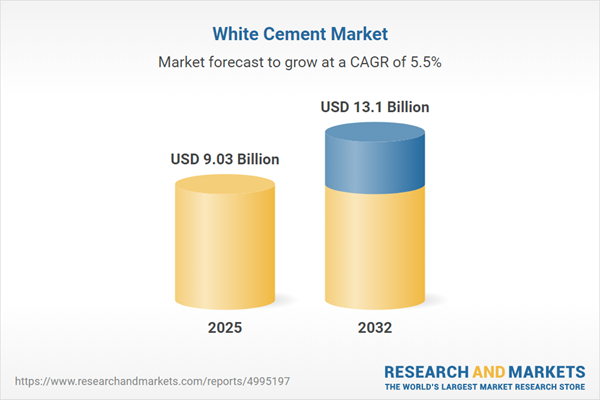Speak directly to the analyst to clarify any post sales queries you may have.
Senior leaders in the white cement sector increasingly require actionable, market-driven intelligence to adjust operational plans and secure competitive advantage. This overview presents essential insights, aiding strategic investment as evolving factors—such as shifting regulation, supply chain complexity, and technology integration—reshape the global white cement market landscape.
White Cement Market Snapshot
The global white cement market continues to progress, underpinned by sustained investments in infrastructure, new construction methods, and increasing demand for specialized cement solutions. Currently, the sector advances at a compound annual growth rate (CAGR) of 5.46%. Robust performance is anchored by rising expectations for innovative finishes and performance attributes. Standards around regulatory compliance and sustainable development now have a significant influence on market evolution. Leading organizations are responding with advanced materials, automated production methods, and adaptable processes that accommodate diverse project needs. Regional market differences—spanning the Americas, EMEA, and Asia-Pacific—require tailored approaches that reflect each area’s regulatory and modernization profile.
Scope & Segmentation of the White Cement Market
This report provides an in-depth perspective on the white cement value chain, equipping decision-makers with tools to optimize strategies and adapt to ongoing market challenges. The following segmentation points support precise analysis of growth levers and operational opportunities:
- Product Types: Bagged formats provide convenient solutions for specialized and limited-access projects; bulk white cement is prioritized for high-volume, ongoing construction needs where supply consistency is critical.
- Application Areas: Architectural finishes, restoration, decorative surfacing, structural repairs, and tile grouting demonstrate flexibility—from aesthetic demands to essential infrastructure remediation.
- End Users: Construction firms, regulatory and public sector institutions, and retail distributors influence procurement patterns, prompting dynamic shifts in service and product delivery models.
- Sales Channels: Direct client interactions and established distributor partnerships enable effective distribution and adaptation to distinct project requirements across markets.
- Geographical Coverage: Regional differences in infrastructure investment, modernization rates, and regulatory frameworks shape competitor strategies throughout the Americas, EMEA, and Asia-Pacific regions.
- Technologies & Market Drivers: The push for environmentally accountable materials, digital project and process management, and transparent supply chains enhances responsiveness and supports long-term resilience.
- Major Players: LafargeHolcim Ltd, HeidelbergCement AG, UltraTech Cement Limited, Cemex S.A.B. de C.V., and JK Cement Limited serve as industry benchmarks, setting expectations for quality and delivery standards throughout the value chain.
Key Takeaways for Senior Decision-Makers
- White cement’s multifaceted properties support compliance with both advanced design considerations and robust project requirements, meeting expectations across demanding application environments.
- Continuous investment in innovation and materials research promotes organizational agility and facilitates response to evolving regulations and client priorities.
- Adoption of optimized supply chain practices, featuring digital controls and real-time data tracking, enables cost containment and mitigates the impacts of market volatility on project delivery.
- Modernization strategies, particularly those incorporating new materials and manufacturing advancements, position suppliers to tailor offerings and proactively address performance and compliance shifts.
- Advanced admixture development and upgraded manufacturing processes drive standardization, improve product scalability, and unlock new avenues for sustainable practice within the white cement value chain.
White Cement Supply Chain: United States Tariff Policy Impact 2025
Adjustments in U.S. tariff policy have prompted white cement stakeholders to reevaluate sourcing and cost optimization across the domestic supply network. U.S.-based producers are reinforcing their positions, while firms dependent on imports are expanding supplier portfolios and leaning on local clinker sources. Increased focus on strict inventory oversight and refined sourcing strategies seeks to safeguard project schedules and stabilize costs in a fluid regulatory environment.
Methodology & Data Sources
The analysis leverages direct interviews with executives, targeted industry surveys, on-site evaluations, and extensively validated secondary research. This triangulated approach ensures that the insights presented offer a credible and actionable resource for benchmarking and decision-making in the white cement sector.
Why This White Cement Market Report Matters
- Helps leadership teams identify new growth opportunities and efficiently address regulatory complexities.
- Aligns procurement, supply chain, and executive teams by clarifying drivers and highlighting actionable market opportunities.
- Enables robust assessment of organizational resilience through transparent supply chains and targeted sustainability initiatives.
Conclusion
By equipping leaders with clear, validated insights, this report facilitates agile responses to change and supports the pursuit of operational excellence within a continually evolving white cement market.
Additional Product Information:
- Purchase of this report includes 1 year online access with quarterly updates.
- This report can be updated on request. Please contact our Customer Experience team using the Ask a Question widget on our website.
Table of Contents
3. Executive Summary
4. Market Overview
7. Cumulative Impact of Artificial Intelligence 2025
Companies Mentioned
The companies profiled in this White Cement market report include:- LafargeHolcim Ltd
- HeidelbergCement AG
- UltraTech Cement Limited
- Cemex, S.A.B. de C.V.
- Buzzi Unicem S.p.A.
- CRH plc
- Vicat SA
- Dangote Cement plc
- JK Cement Limited
- Ciment Québec Inc.
Table Information
| Report Attribute | Details |
|---|---|
| No. of Pages | 190 |
| Published | October 2025 |
| Forecast Period | 2025 - 2032 |
| Estimated Market Value ( USD | $ 9.03 Billion |
| Forecasted Market Value ( USD | $ 13.1 Billion |
| Compound Annual Growth Rate | 5.4% |
| Regions Covered | Global |
| No. of Companies Mentioned | 11 |









